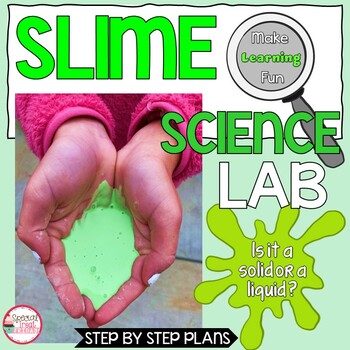Science Experiments with Slime Oobleck Science Lab Experiment
- PDF
What educators are saying
Also included in
- The most memorable lessons your students will remember are the interactive Science Labs. Almost all students love seeing science reactions, getting their hands dirty, and interacting with their learning. In this bundle you will have Science Labs for the whole year. Each of the labs comes complete wiPrice $10.50Original Price $20.50Save $10.00
Description
What kid doesn't love making and touching slime?! This Oobleck Slime Science Lab will introduce your students to the Scientific Method as well as gain excitement for Science through slime. #FSSparklers23
With slime being all the rage with kids these days, Oobleck fits right in, plus it is so easy and cheap to make.
Your students watch YouTube videos on how to make slime, they convince their parents to buy the ingredients and attempt to make it at home. Why not do a Science Experiment with slime?
OVERVIEW
In this Science Experiment with slime, students learn briefly the difference between a solid, liquid, and gas. Then using the Scientific Method, students will go through each step, to make slime. They will fill out lab sheets or use the lab books and answer the question, "Is Oobleck a solid or liquid?" The students will make observations and answer the various reflection questions after.
INCLUDED
- Step by Step Detailed Lesson Plans
- Oobleck Slime Lab Sheets
- Extension Lab Activity
- Slime Lab books (available in color & black and white)
- Mini Lab Book (available in color & black and white)
- Reflection Sheet of Questions for after the lab
- Lab instructions
- Explain the lab to a friend sheets
- Scientific Method Posters
Warning: This is very messy and will make your students like you better!
YOUR STUDENTS WILL
Your students will gain a better knowledge of the Scientific Method process using this science lab. They will learn the difference between a solid, liquid, and gas. They will get a chance to actively participate in their learning and will get to take home their experiment and lab books to explain the experiment to their family and friends.
Everything is included except the ingredients!
For more information on how this will look in your classroom, hop on over to our BLOG!
You may also be interested in my Solar System Interactive Science Unit.
Don’t forget that leaving feedback earns you points toward FREE TPT purchases. I love FEEDBACK!
LET'S CONNECT Special Treat Friday Blog | Writing Membership | TPT | Facebook | Instagram | YouTube
As always, please contact me with any questions.
Make Teaching Fun This Week,
Special Treat Friday, Heather McKinsey






